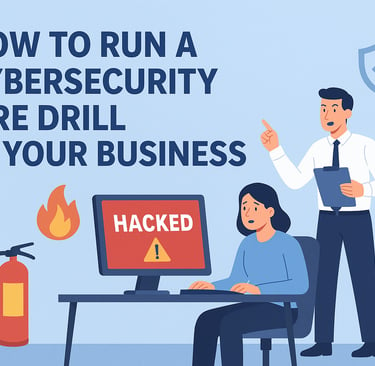How to Run a Cybersecurity Fire Drill in Your Business
Blog post description.


How to Run a Cybersecurity Fire Drill in Your Business
Think about the last time your office had a real fire drill. The alarms blared, everyone filed outside, some people forgot their jackets, others grabbed their coffee like it was the last one on Earth. It was a little chaotic, but everyone learned what to do if an actual fire broke out.
Now, here’s the question:
When was the last time your business ran a cybersecurity fire drill?
If your answer is never, you’re not alone. Most small businesses and even large corporations have never tested what would happen if a cyber incident, like a ransomware attack or phishing breach, hit their systems.
And that’s a problem.
Why Cyber Fire Drills Matter
Let’s be real: your team’s first few minutes of response can make or break how your company weathers a cyberattack.
If your staff doesn’t know what to do, panic sets in, mistakes multiply, and suddenly that “minor breach” turns into a week of downtime and a few sleepless nights.
Cyber drills are like a business continuity test for your digital world. They build muscle memory so that when things go sideways, your people respond like pros, not deer in headlights.
Step 1: Start with a Scenario
Don’t overcomplicate it, pick one realistic threat to simulate:
A phishing email that compromises an executive account.
A ransomware attack that locks your files.
A data breach exposing customer information.
Keep it grounded in something that could happen to your business, not just Hollywood-style hacking.
Step 2: Identify Your Response Team
Who’s doing what when things go wrong?
Your IT team (or managed provider) should take point, but everyone plays a role, from leadership to HR to communications.
Pro tip: assign one person as the “Incident Commander.” They don’t need to be a tech genius; they just need to coordinate decisions and communication.
Step 3: Practice Containment
This is where the action happens. Test how your systems would be isolated, what data backups you’d rely on, and how communication flows internally and externally.
Think of it as testing your company’s reflexes. The faster and cleaner the response, the smaller the damage.
Step 4: Communicate Like a Pro
During the drill, simulate how you’d inform your team, your customers, and (if needed) regulators.
One of the biggest mistakes during a real breach? Silence.
Your employees should know what’s happening, what’s safe to do, and what not to click.
Step 5: Debrief & Improve
After every fire drill, ask: what worked, what didn’t, and how do we do better next time?
Document the lessons learned and update your incident response plan accordingly. You’ll be amazed how quickly your organization becomes more confident and resilient.
The Takeaway
Cybersecurity isn’t just about software and firewalls, it’s about people and preparation.
When your team knows how to respond, you’re not just protecting data, you’re protecting your reputation, your revenue, and your peace of mind.
So, if you haven’t scheduled your first cybersecurity fire drill yet, now’s the time to start.
We can help you design and run one that fits your business, without the tech jargon or chaos.
👉 Contact us at Deosh Group to set up your customized cybersecurity fire drill today.
Because in the digital world, practice doesn’t just make perfect, it keeps you protected.
